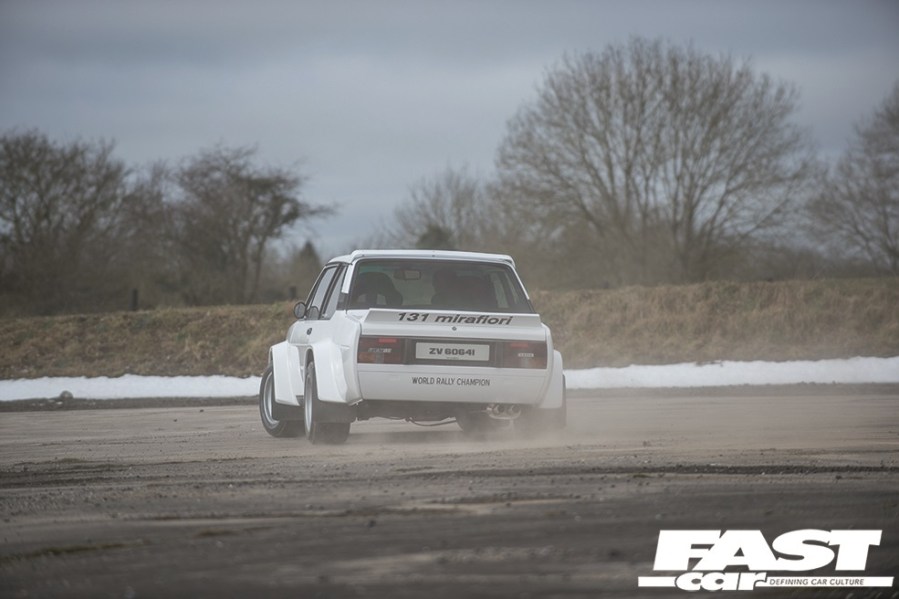David Curley’s finally turned his four-wheeled childhood fantasy into a reality with an Abarth 131 rally-rep, that acts as the perfect tribute to a WRC-winning Italian icon…
It’s funny how even the tiniest things you pick up on during childhood can have an effect on the way you live the rest of your life.
Take rally-obsessed David here as a prime example. His list of recent motors might include countless infamous homologated ‘70s, ‘80s and ‘90s metal that would be enough to make most car fans weak at the knees, but he wasn’t truly happy until he’d sold them all off and finished his very latest project. And to think it all started with a poster hanging up in his uncle’s garage a couple of decades ago…
“The earliest memory of a rally car I have is when I walked into my uncle’s workshop back when I was around eight years old,” he begins the tale of how he came to own this slice of Italian history. “There was a massive dealership poster of the fabulous Fiat Abarth 131, complete in the famous ‘Olio Fiat’ livery.”
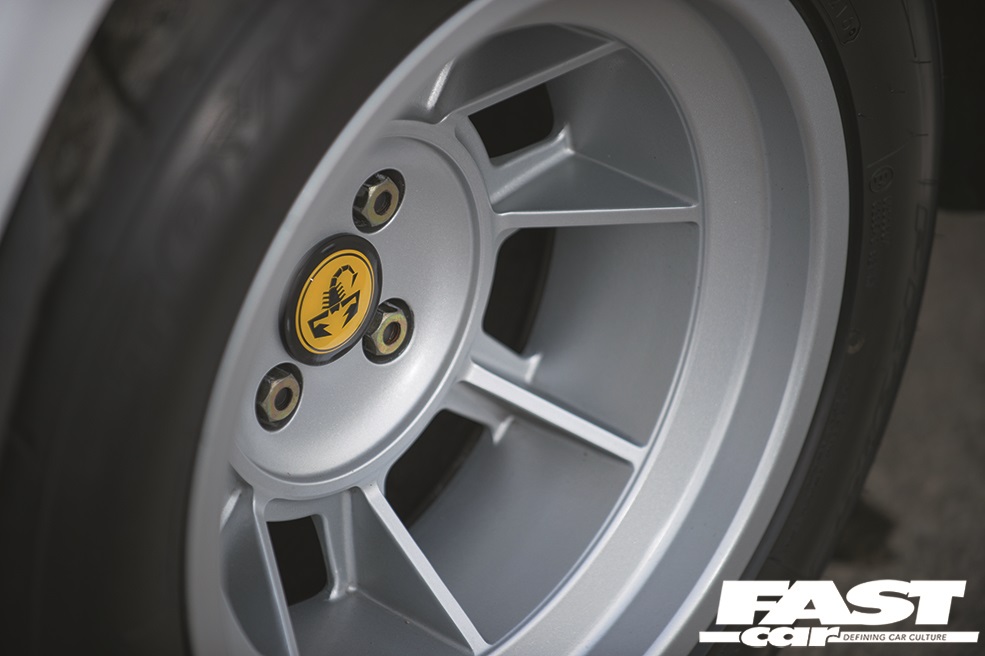
Boasting those bubbling wings that set off its sharp ‘70s styling, as well as three WRC victories in the same decade under the control of drivers such as Walter Röhrl. This hugely successful race machine had more of an impact on David’s adult life than he perhaps could have ever dreamed of at that point, eventually spawning a life-long ambition to one day own a replica of this very car for himself.
With his father owning several road-going examples of this family saloon further into his childhood, and David himself even managing to snap up a silver 131 as his very first car around a decade later, it was clear that this was an obsession that was not going away in a hurry. As the ‘90s came around he was in a position to begin taking on a project car of his own, it probably comes as little surprise to hear that the first vehicle he wanted to whip up was a replica of one of the 400 homologated road-going versions of the 131. “I eventually sold off that car to fund my next project, though; a Ford RS200 replica, but I knew I’d always come back to the Fiat one day.”
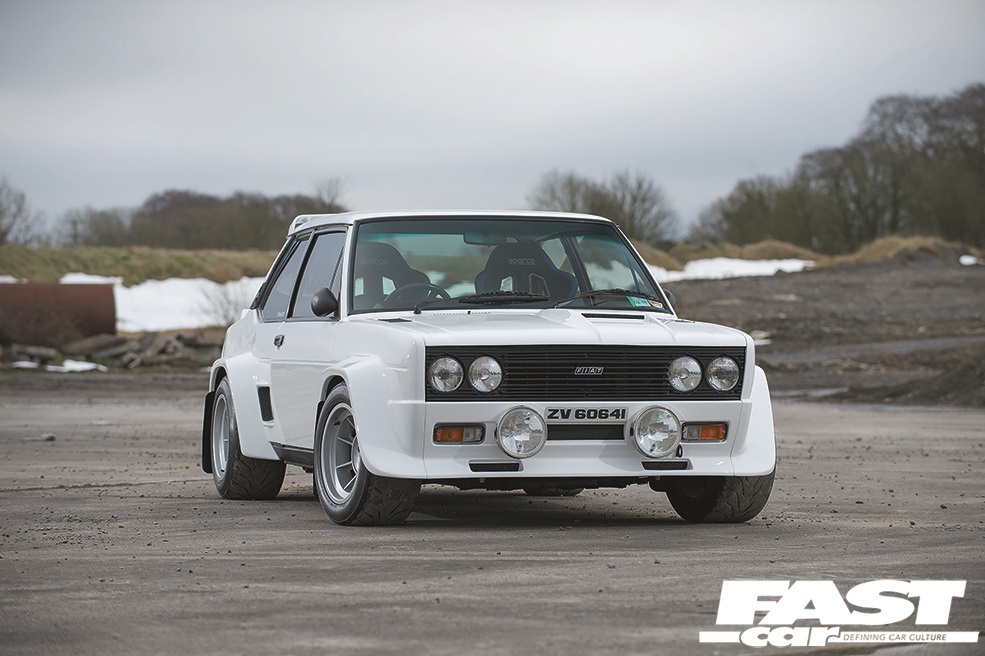
This brings us neatly up to just a couple of years ago, when David had finally convinced himself it was time to undertake the gruelling task of recreating his own Group 4 Fiat that would stick as close to the motorsport machines as possible, while retaining number plates so he could use the car to pick up the milk on a Sunday morning in as stylish way possible.
The mammoth job began by sourcing the base car – a low-mileage 1300cc ‘L’ two-door that looked a million miles from the muscular weapon Mr Rörhl had piloted all those years earlier. No bother for David, though, who was willing to do anything it took to transform the car into the icon his eight-year-old self drooled over back in the day. And what he did to the car as soon as he got it home proved he wasn’t messing around, right from the start…
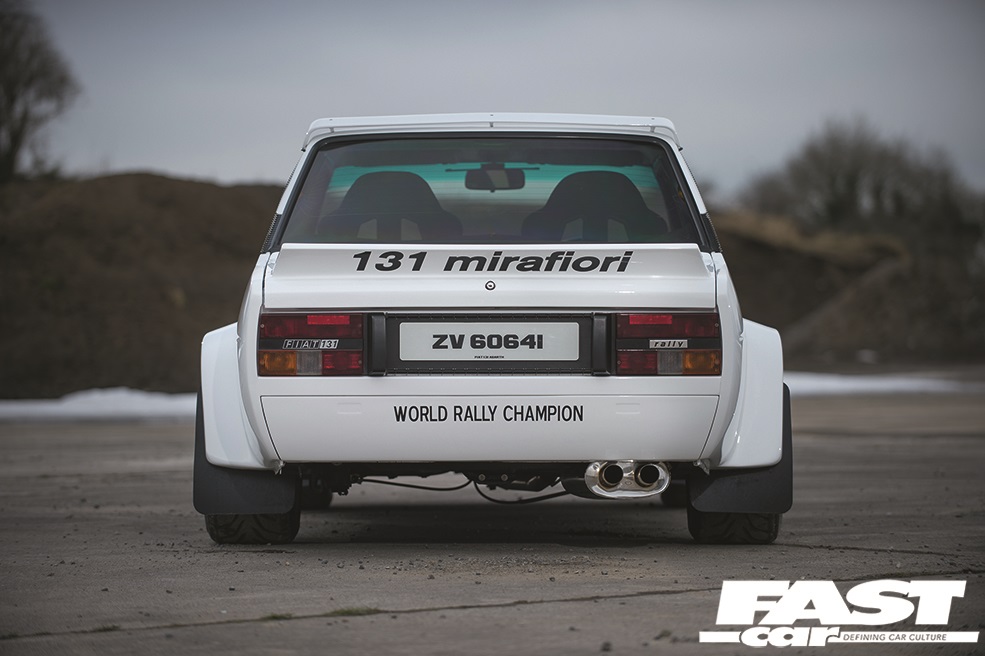
“It spent its first year on a spit as I stripped the shell back and replaced every nut and bolt,” David tells us. “After all the necessary repairs were made, the floor and cross-member were also seam-welded to improve strength and rigidity.” Going the whole hog as styling house Bertone would have done to the genuine homologation machines. Even smaller details like re-creating a strengthening frame that sat behind the quarter panels on the Abarth versions were thought of along the way.
An immensely solid base under his belt, David’s next move was to get the car looking the part with arguably one of the signature aspects of the entire project – that bonkers wide-arch body kit. “All factory Abarths had these fibreglass kits as well as aluminium door skins, so to stay true to the Bertone design I had to source the same.” David explains. Luckily Malton-based Rallysport Development just happened to have this ‘Tarmac Rally Kit’ on the shelf and ready to go.
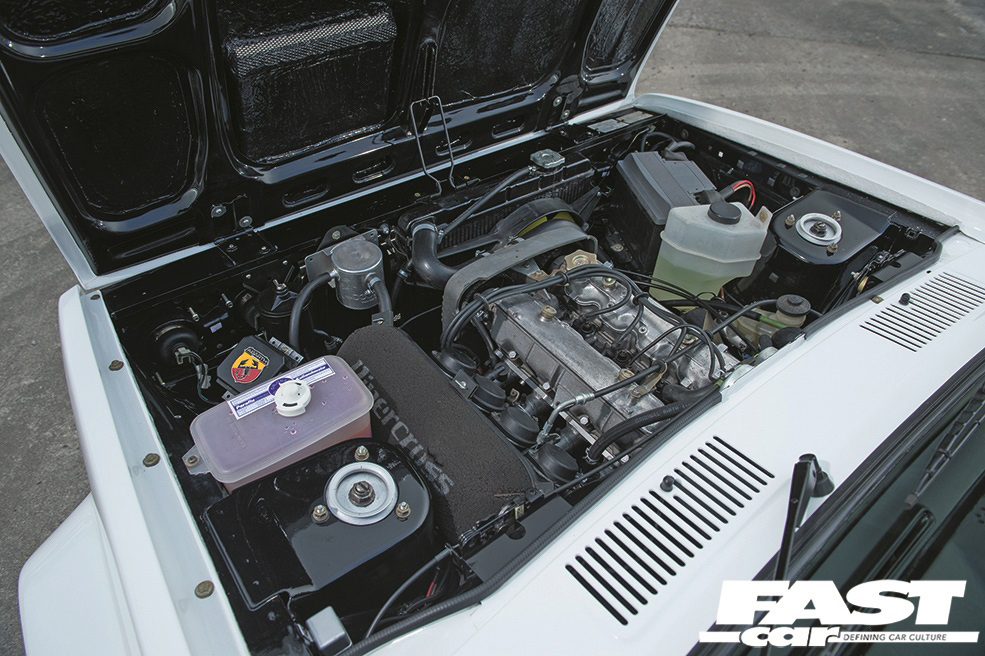
Comprising of fibreglass widened wings, quarter panels, bonnet, boot lid and spoilers, as well as the all-important door skins, David clearly had his work cut out getting it all to attach seamlessly to the car’s standard lines. As an out-and-out motorsport kit, he also added a few road-friendly touches along the way, such as a metal plate on the boot that would allow him to still lock the car when out and about. In this alone he’s shown some seriously cool attention-to-detail that many would be happy to overlook. Once finished, the exterior was topped off with an Abarth front Grille and a new set of period-perfect Carello spotlights to really set off the crisp white lines.
Receiving an equally impressive level of attention was the chassis. Already sporting a relatively modern setup from the factory, David has capitalised on this by adding Bilstein coilovers on each corner, larger disc brakes from an Alfa Romeo, as well as a Group 4 hub conversion that means he can now run those immensely wide Campagnola-style wheels safely – another great touch that simultaneously fills those signature wings.
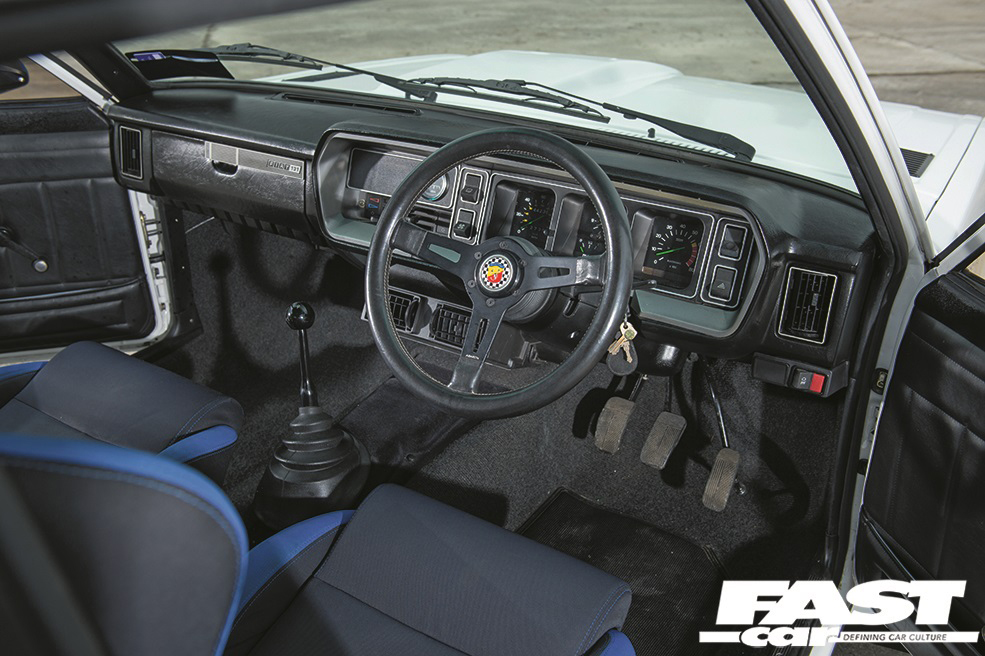
With the homologation example originally using a slightly hotter version of the four-cylinder engine that came in the standard road car, David thought he’d use some creative license to take things a step further in the hunt for power. Eventually he came up with an ingenious solution in the form of a 2-litre twin-cam screamer from the slightly more modern Fiat Strada Abarth 130 hot hatch. “I chose this engine because I felt it was the last proper twin-cam, 8V motor produced by Abarth.”
Clearly he sees this particular unit as something of a swansong for this era of powertrains. This one’s not only been fully re-built and converted to power the rear wheels by David, but also enhanced with some Yamaha carburettors on a custom manifold, and a straight-through exhaust system from Dublin-based Exhaust Worx. It’s then up to the five-speed ‘box and a sturdier rear axle from a Fiat 132 (complete with an LSD as standard) to distribute the impressive grunt to the rear wheels.
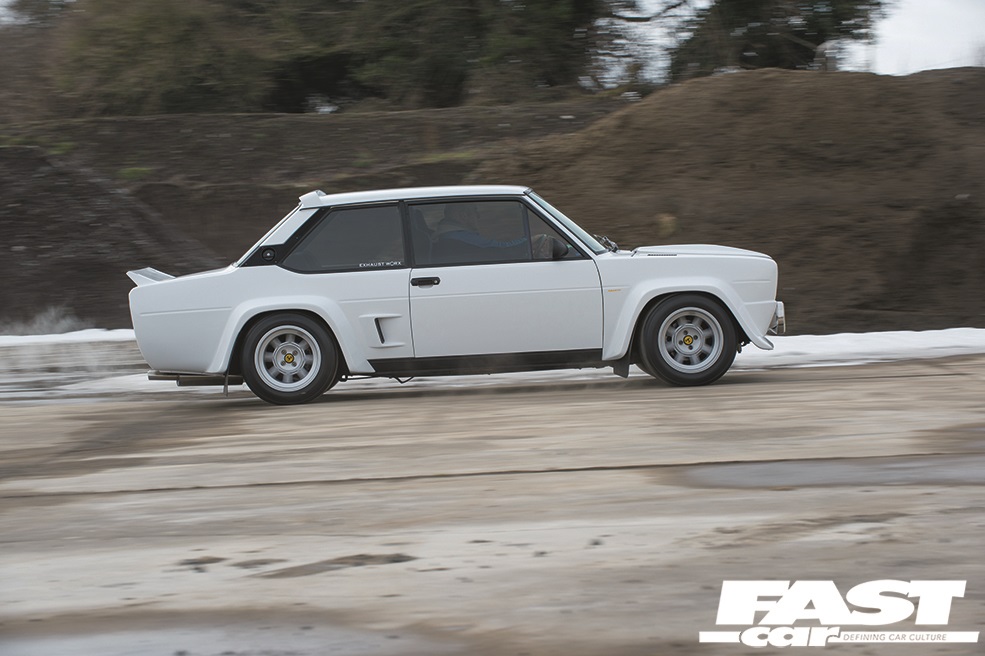
By combining his knowledge of this rare model, and utilising some clever modern touches along the way, David’s been left with a machine that more than lives up to his childhood poster car. It may have been a long time coming, but it was easily worth the wait.
Tech Spec: Fiat 131
Engine
2.0-litre DOHC 8V engine (from Fiat Strada Abarth 130 Twin Cam), fully re-built and converted to run in RWD format, quad carburettor setup from Yamaha R1 mounted on custom Bogg Brothers inlet manifold, full Exhaust Worx custom exhaust system, five-speed manual gearbox with short-shift (from Fiat 131 Sport), Fiat 132 rear axle with LSD (and factory disc brake upgrade)
Chassis
9×15-inch (front) and 10×15-inch (rear) Campagnola-style alloy wheels, Toyo R888 semi-slick tyres, Group 4 four-stud hub conversion (all-round), adjustable coilover suspension conversion with Bilstein inserts, Abarth 131-style strengthening frame, overhauled braking system with Alfa Romeo calipers, larger ventilated discs, braided lines and uprated servo/master cylinder
Exterior
Full nut-and-bolt shell restoration, seam-welded floor and cross-member, Full Rallysport Development ‘Tarmac Rally Kit’ (comprising fibreglass Group 4-spec wide wings, quarter panels, bonnet, boot lid, roof spoiler, front spoiler, rear blanking plate and aluminium door skins), Abarth front grille, Carello lamps and indicators
Interior
Sparco R100 reclining bucket seats with four-point harnesses
Thanks
“Big thanks to Alan Browne, Trevor Faulkner, Nick Casey, Tony Phillips, Michael Curley and Alan Clarke for their assistance at different stages of the build. Also to Yagmur at Rainspeed and Ele at Ricambi Storici for sourcing all those hard-to-get parts and Jonathan at Group 4 Wheels… not forgetting of course my family: Carol, Eoin & Shona, for all the nights of me saying ‘’could someone just come out to the garage for a minute?’’ and them always obliging, many thanks!”
Feature taken from Retro Cars magazine. Words: Sam Preston. Photos: Ade Brannan.

